COIT20248: Information Systems Development for UNICEF Child Care
VerifiedAdded on 2023/06/13
|13
|2808
|124
Report
AI Summary
This report details the development of a new information system for UNICEF Child Care to address inefficiencies in their manual processes. The project focuses on creating a user-friendly portal with online registration and payment options, automated invoice generation, and an auto-ordering system to prevent resource wastage. The chosen development methodology is prototyping, allowing for iterative testing and refinement. The report outlines both functional (login, online payment, auto-ordering) and non-functional (database server, system security, device support) requirements. A cost-benefit analysis demonstrates the project's potential ROI, and a project schedule, including a Gantt chart and work breakdown structure, provides a timeline for development. The report also identifies key stakeholders and discusses system information requirement investigation techniques. This project aims to enhance UNICEF Child Care's operational efficiency and resource management through a modern, secure, and accessible information system.
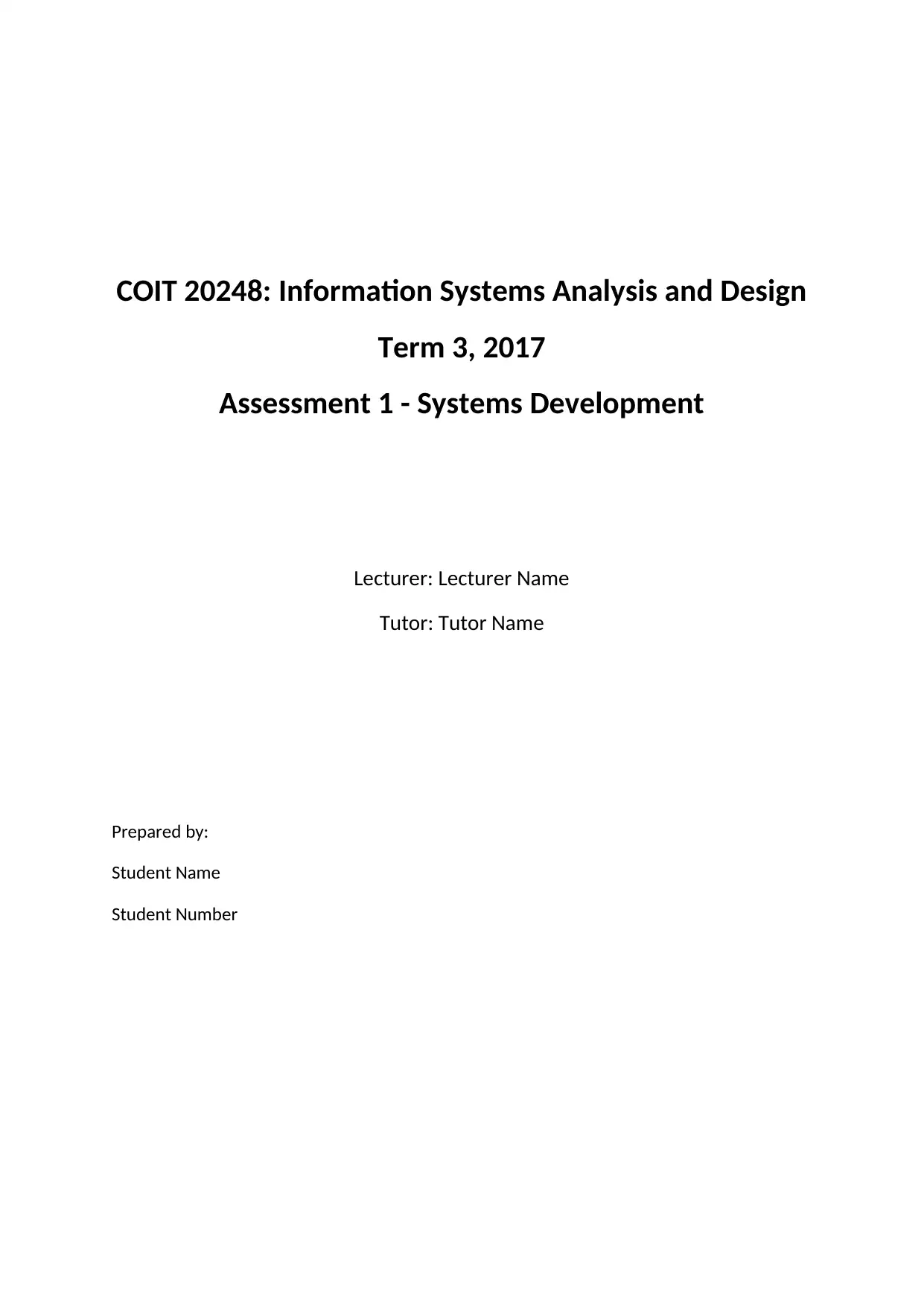
COIT 20248: Information Systems Analysis and Design
Term 3, 2017
Assessment 1 - Systems Development
Lecturer: Lecturer Name
Tutor: Tutor Name
Prepared by:
Student Name
Student Number
Term 3, 2017
Assessment 1 - Systems Development
Lecturer: Lecturer Name
Tutor: Tutor Name
Prepared by:
Student Name
Student Number
Paraphrase This Document
Need a fresh take? Get an instant paraphrase of this document with our AI Paraphraser
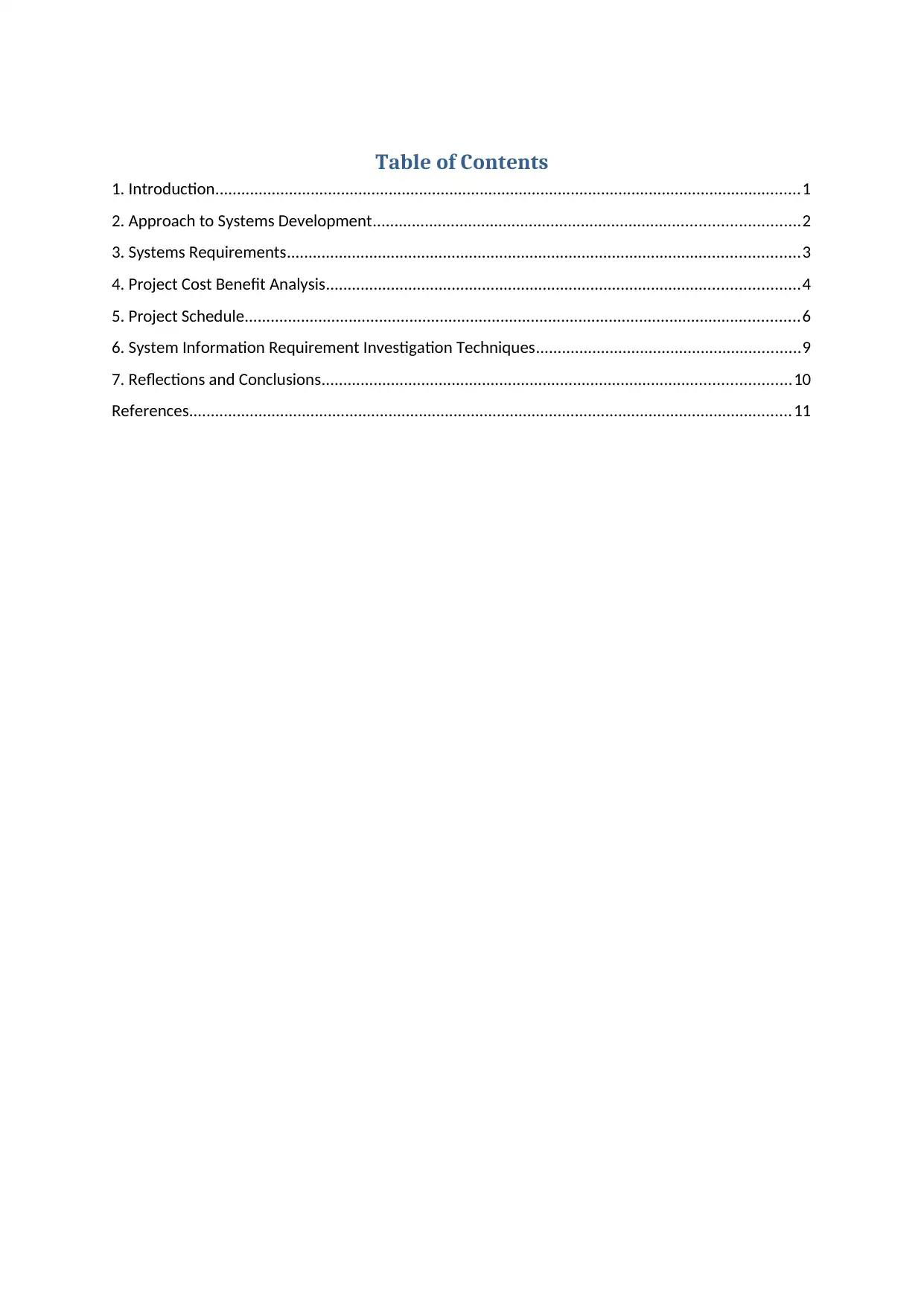
Table of Contents
1. Introduction.......................................................................................................................................1
2. Approach to Systems Development..................................................................................................2
3. Systems Requirements......................................................................................................................3
4. Project Cost Benefit Analysis.............................................................................................................4
5. Project Schedule................................................................................................................................6
6. System Information Requirement Investigation Techniques.............................................................9
7. Reflections and Conclusions............................................................................................................10
References...........................................................................................................................................11
1. Introduction.......................................................................................................................................1
2. Approach to Systems Development..................................................................................................2
3. Systems Requirements......................................................................................................................3
4. Project Cost Benefit Analysis.............................................................................................................4
5. Project Schedule................................................................................................................................6
6. System Information Requirement Investigation Techniques.............................................................9
7. Reflections and Conclusions............................................................................................................10
References...........................................................................................................................................11

1. Introduction
This project is based on the development of a new information system for UNICEF Child
Care that deals with the caring and supervision of children under thirteen. They have a
particular scheme in which, the parents of the children will pay certain amount of sum of
money and with the same, UNICEF will buy and provide food, study materials, toys and
other objects required for the development of the children. However, with the manual
system used for handling of the money and purchase of the materials, the center is facing
some problems that result in the wastage of resources. In order to solve these problems,
this particular project has been developed and approved by the chairman of the
organization John Smith.
Based on the requirements of the project, the objectives can be determined as follows.
To develop a new information system for UNICEF Child Care
To develop a user profile system with user authentication procedure
To include an online payment option for the parents of the children
To add cyber security measures to the online payment gateway
To develop an automated ordering system that will take input from the number of
orders placed
Page 1
This project is based on the development of a new information system for UNICEF Child
Care that deals with the caring and supervision of children under thirteen. They have a
particular scheme in which, the parents of the children will pay certain amount of sum of
money and with the same, UNICEF will buy and provide food, study materials, toys and
other objects required for the development of the children. However, with the manual
system used for handling of the money and purchase of the materials, the center is facing
some problems that result in the wastage of resources. In order to solve these problems,
this particular project has been developed and approved by the chairman of the
organization John Smith.
Based on the requirements of the project, the objectives can be determined as follows.
To develop a new information system for UNICEF Child Care
To develop a user profile system with user authentication procedure
To include an online payment option for the parents of the children
To add cyber security measures to the online payment gateway
To develop an automated ordering system that will take input from the number of
orders placed
Page 1
⊘ This is a preview!⊘
Do you want full access?
Subscribe today to unlock all pages.

Trusted by 1+ million students worldwide

2. Approach to Systems Development
There are several systems development methods available and a particular one is chosen
based on the requirements of the system. Hence, in order to determine the systems
development method most suitable for the project, first the features of the system need to
be analysed. For this project, the proposed system features are as follows.
User Portal – In order to initiate online registration of users and payments, a user portal
needs to be created. This portal will have a login system through which a user (parent of a
child) can register and then log in using an email id / unique username and a unique
password (Špundak 2014). In this profile, the user can upload his details including the details
of his child and can also have the option of make online payments to UNICEF.
Auto-Generated Invoice System – One problem of the system to be addressed is the
publication of invoice for the payments made by the user. Hence, one proposed feature of
the system is to generate a digital invoice that is to be sent to the user immediately after a
payment is made.
Auto Order – Finally, the main requirement of the system is to send an order to the seller
automatically once a new user is registered in the portal. This feature will prevent the issue
of shortage or wastage of materials and resources (Serrador and Pinto 2015).
Based on the requirements of the system, it can be said that the most suitable systems
development methodology is prototyping.
Justification – Prototyping process will allow the developer to create the prototype of the
entire system at once and then perform various tests on it. Since the system requires a
number of different features, following other conventional development methodologies will
consume a significant amount of time and cost. A general prototyping model is shown in the
following diagram.
Figure 1: Prototyping Systems Development Method
(Source: )
Page 2
There are several systems development methods available and a particular one is chosen
based on the requirements of the system. Hence, in order to determine the systems
development method most suitable for the project, first the features of the system need to
be analysed. For this project, the proposed system features are as follows.
User Portal – In order to initiate online registration of users and payments, a user portal
needs to be created. This portal will have a login system through which a user (parent of a
child) can register and then log in using an email id / unique username and a unique
password (Špundak 2014). In this profile, the user can upload his details including the details
of his child and can also have the option of make online payments to UNICEF.
Auto-Generated Invoice System – One problem of the system to be addressed is the
publication of invoice for the payments made by the user. Hence, one proposed feature of
the system is to generate a digital invoice that is to be sent to the user immediately after a
payment is made.
Auto Order – Finally, the main requirement of the system is to send an order to the seller
automatically once a new user is registered in the portal. This feature will prevent the issue
of shortage or wastage of materials and resources (Serrador and Pinto 2015).
Based on the requirements of the system, it can be said that the most suitable systems
development methodology is prototyping.
Justification – Prototyping process will allow the developer to create the prototype of the
entire system at once and then perform various tests on it. Since the system requires a
number of different features, following other conventional development methodologies will
consume a significant amount of time and cost. A general prototyping model is shown in the
following diagram.
Figure 1: Prototyping Systems Development Method
(Source: )
Page 2
Paraphrase This Document
Need a fresh take? Get an instant paraphrase of this document with our AI Paraphraser
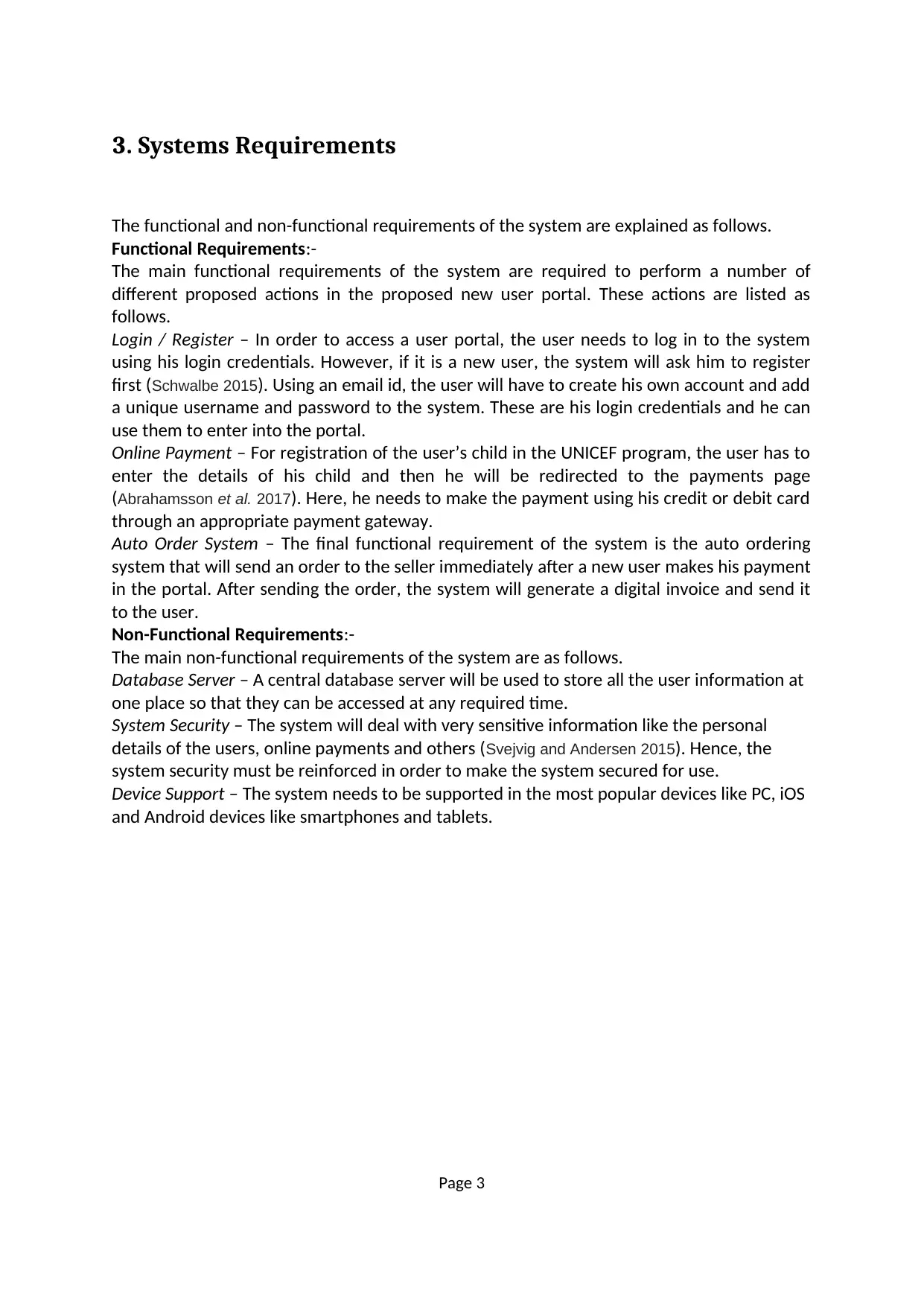
3. Systems Requirements
The functional and non-functional requirements of the system are explained as follows.
Functional Requirements:-
The main functional requirements of the system are required to perform a number of
different proposed actions in the proposed new user portal. These actions are listed as
follows.
Login / Register – In order to access a user portal, the user needs to log in to the system
using his login credentials. However, if it is a new user, the system will ask him to register
first (Schwalbe 2015). Using an email id, the user will have to create his own account and add
a unique username and password to the system. These are his login credentials and he can
use them to enter into the portal.
Online Payment – For registration of the user’s child in the UNICEF program, the user has to
enter the details of his child and then he will be redirected to the payments page
(Abrahamsson et al. 2017). Here, he needs to make the payment using his credit or debit card
through an appropriate payment gateway.
Auto Order System – The final functional requirement of the system is the auto ordering
system that will send an order to the seller immediately after a new user makes his payment
in the portal. After sending the order, the system will generate a digital invoice and send it
to the user.
Non-Functional Requirements:-
The main non-functional requirements of the system are as follows.
Database Server – A central database server will be used to store all the user information at
one place so that they can be accessed at any required time.
System Security – The system will deal with very sensitive information like the personal
details of the users, online payments and others (Svejvig and Andersen 2015). Hence, the
system security must be reinforced in order to make the system secured for use.
Device Support – The system needs to be supported in the most popular devices like PC, iOS
and Android devices like smartphones and tablets.
Page 3
The functional and non-functional requirements of the system are explained as follows.
Functional Requirements:-
The main functional requirements of the system are required to perform a number of
different proposed actions in the proposed new user portal. These actions are listed as
follows.
Login / Register – In order to access a user portal, the user needs to log in to the system
using his login credentials. However, if it is a new user, the system will ask him to register
first (Schwalbe 2015). Using an email id, the user will have to create his own account and add
a unique username and password to the system. These are his login credentials and he can
use them to enter into the portal.
Online Payment – For registration of the user’s child in the UNICEF program, the user has to
enter the details of his child and then he will be redirected to the payments page
(Abrahamsson et al. 2017). Here, he needs to make the payment using his credit or debit card
through an appropriate payment gateway.
Auto Order System – The final functional requirement of the system is the auto ordering
system that will send an order to the seller immediately after a new user makes his payment
in the portal. After sending the order, the system will generate a digital invoice and send it
to the user.
Non-Functional Requirements:-
The main non-functional requirements of the system are as follows.
Database Server – A central database server will be used to store all the user information at
one place so that they can be accessed at any required time.
System Security – The system will deal with very sensitive information like the personal
details of the users, online payments and others (Svejvig and Andersen 2015). Hence, the
system security must be reinforced in order to make the system secured for use.
Device Support – The system needs to be supported in the most popular devices like PC, iOS
and Android devices like smartphones and tablets.
Page 3

4. Project Cost Benefit Analysis
Cost benefit analysis is done in order to determine the possible amount of profit that can be
earned from the project. For this project, the cost benefit analysis is done as follows.
Cost Benefit Analysis for UNICEF Case Study
Hardware $ 75,000.00
Software $ 75,000.00
Development team salaries $ 70,000.00
Training $ 5,000.00
Total Development Cost $ 225,000.00
Maintenance $ 6,000.00
Changes $ 3,000.00
Operational Labor $ 50,000.00
Total Operational Cost $ 59,000.00
Approximate salary savings $ 54,000.00
Reduced Food Wastage $ 60,000.00
Total Benefit $ 114,000.00
Discount Rate Used 6.00%
Table 1: Cost Inputs
Project Cost-
Benefit
Analysis
Analysis
Variables:
Discount
Rate Used 6.00%
Annual
Benefits
$
114,00
0.00
Annual
Operational
Costs
$
59,000
.00
One-Time
Development
Cost
$
225,00
0.00
Year of
Project
0 1 2 3 4 5
TOTAL
S
Economic
Benefit $0.00
$
114,000
.00
$
114,000
.00
$
114,000.
00
$
114,000
.00
$
114,000
.00
Discount Rate
1.000
0 0.9434 0.8900 0.8396 0.7921 0.7473
PV of Benefits $0.00 $107,54 $101,45 $95,716. $90,298 $85,187
Page 4
Cost benefit analysis is done in order to determine the possible amount of profit that can be
earned from the project. For this project, the cost benefit analysis is done as follows.
Cost Benefit Analysis for UNICEF Case Study
Hardware $ 75,000.00
Software $ 75,000.00
Development team salaries $ 70,000.00
Training $ 5,000.00
Total Development Cost $ 225,000.00
Maintenance $ 6,000.00
Changes $ 3,000.00
Operational Labor $ 50,000.00
Total Operational Cost $ 59,000.00
Approximate salary savings $ 54,000.00
Reduced Food Wastage $ 60,000.00
Total Benefit $ 114,000.00
Discount Rate Used 6.00%
Table 1: Cost Inputs
Project Cost-
Benefit
Analysis
Analysis
Variables:
Discount
Rate Used 6.00%
Annual
Benefits
$
114,00
0.00
Annual
Operational
Costs
$
59,000
.00
One-Time
Development
Cost
$
225,00
0.00
Year of
Project
0 1 2 3 4 5
TOTAL
S
Economic
Benefit $0.00
$
114,000
.00
$
114,000
.00
$
114,000.
00
$
114,000
.00
$
114,000
.00
Discount Rate
1.000
0 0.9434 0.8900 0.8396 0.7921 0.7473
PV of Benefits $0.00 $107,54 $101,45 $95,716. $90,298 $85,187
Page 4
⊘ This is a preview!⊘
Do you want full access?
Subscribe today to unlock all pages.

Trusted by 1+ million students worldwide
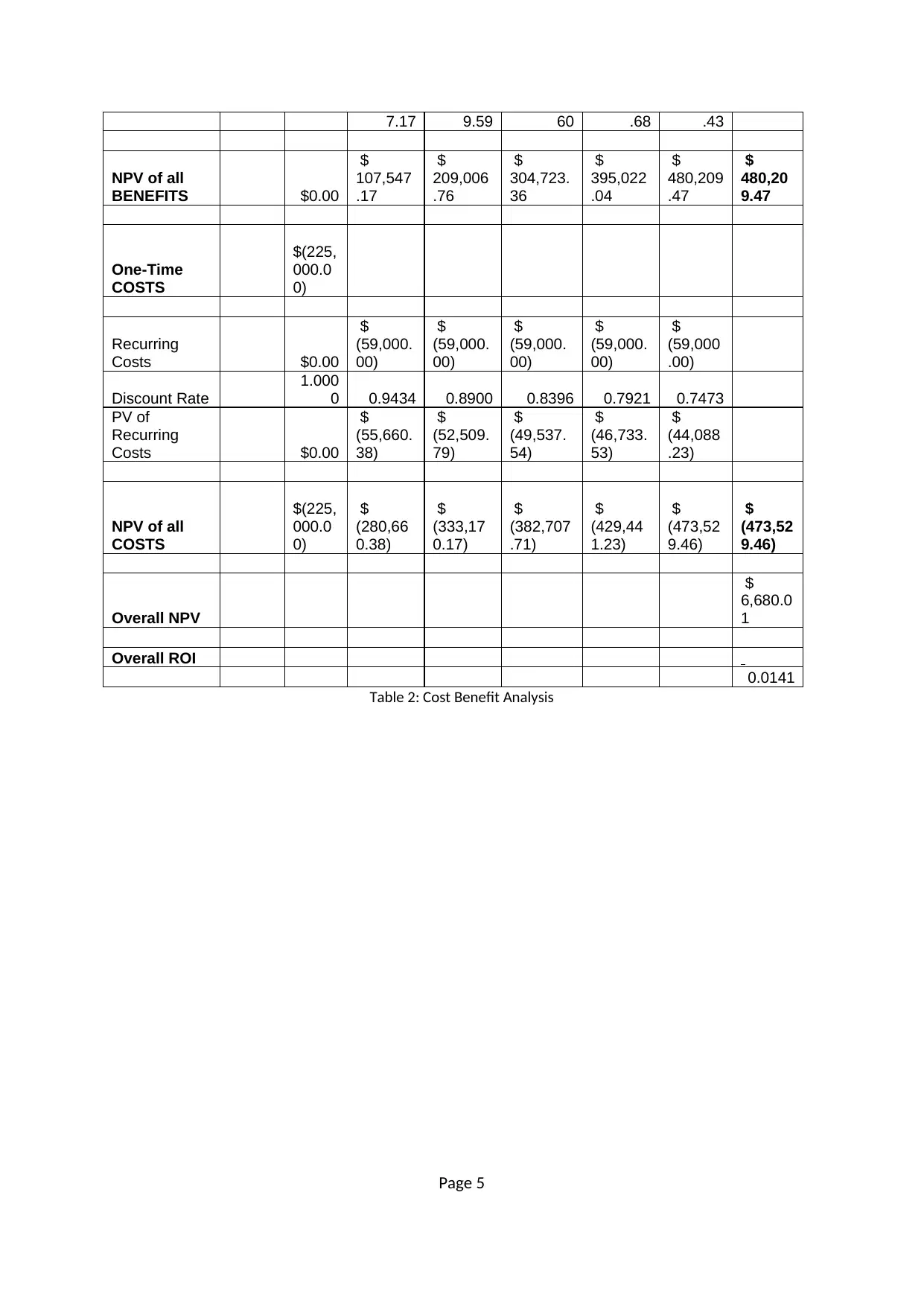
7.17 9.59 60 .68 .43
NPV of all
BENEFITS $0.00
$
107,547
.17
$
209,006
.76
$
304,723.
36
$
395,022
.04
$
480,209
.47
$
480,20
9.47
One-Time
COSTS
$(225,
000.0
0)
Recurring
Costs $0.00
$
(59,000.
00)
$
(59,000.
00)
$
(59,000.
00)
$
(59,000.
00)
$
(59,000
.00)
Discount Rate
1.000
0 0.9434 0.8900 0.8396 0.7921 0.7473
PV of
Recurring
Costs $0.00
$
(55,660.
38)
$
(52,509.
79)
$
(49,537.
54)
$
(46,733.
53)
$
(44,088
.23)
NPV of all
COSTS
$(225,
000.0
0)
$
(280,66
0.38)
$
(333,17
0.17)
$
(382,707
.71)
$
(429,44
1.23)
$
(473,52
9.46)
$
(473,52
9.46)
Overall NPV
$
6,680.0
1
Overall ROI
0.0141
Table 2: Cost Benefit Analysis
Page 5
NPV of all
BENEFITS $0.00
$
107,547
.17
$
209,006
.76
$
304,723.
36
$
395,022
.04
$
480,209
.47
$
480,20
9.47
One-Time
COSTS
$(225,
000.0
0)
Recurring
Costs $0.00
$
(59,000.
00)
$
(59,000.
00)
$
(59,000.
00)
$
(59,000.
00)
$
(59,000
.00)
Discount Rate
1.000
0 0.9434 0.8900 0.8396 0.7921 0.7473
PV of
Recurring
Costs $0.00
$
(55,660.
38)
$
(52,509.
79)
$
(49,537.
54)
$
(46,733.
53)
$
(44,088
.23)
NPV of all
COSTS
$(225,
000.0
0)
$
(280,66
0.38)
$
(333,17
0.17)
$
(382,707
.71)
$
(429,44
1.23)
$
(473,52
9.46)
$
(473,52
9.46)
Overall NPV
$
6,680.0
1
Overall ROI
0.0141
Table 2: Cost Benefit Analysis
Page 5
Paraphrase This Document
Need a fresh take? Get an instant paraphrase of this document with our AI Paraphraser
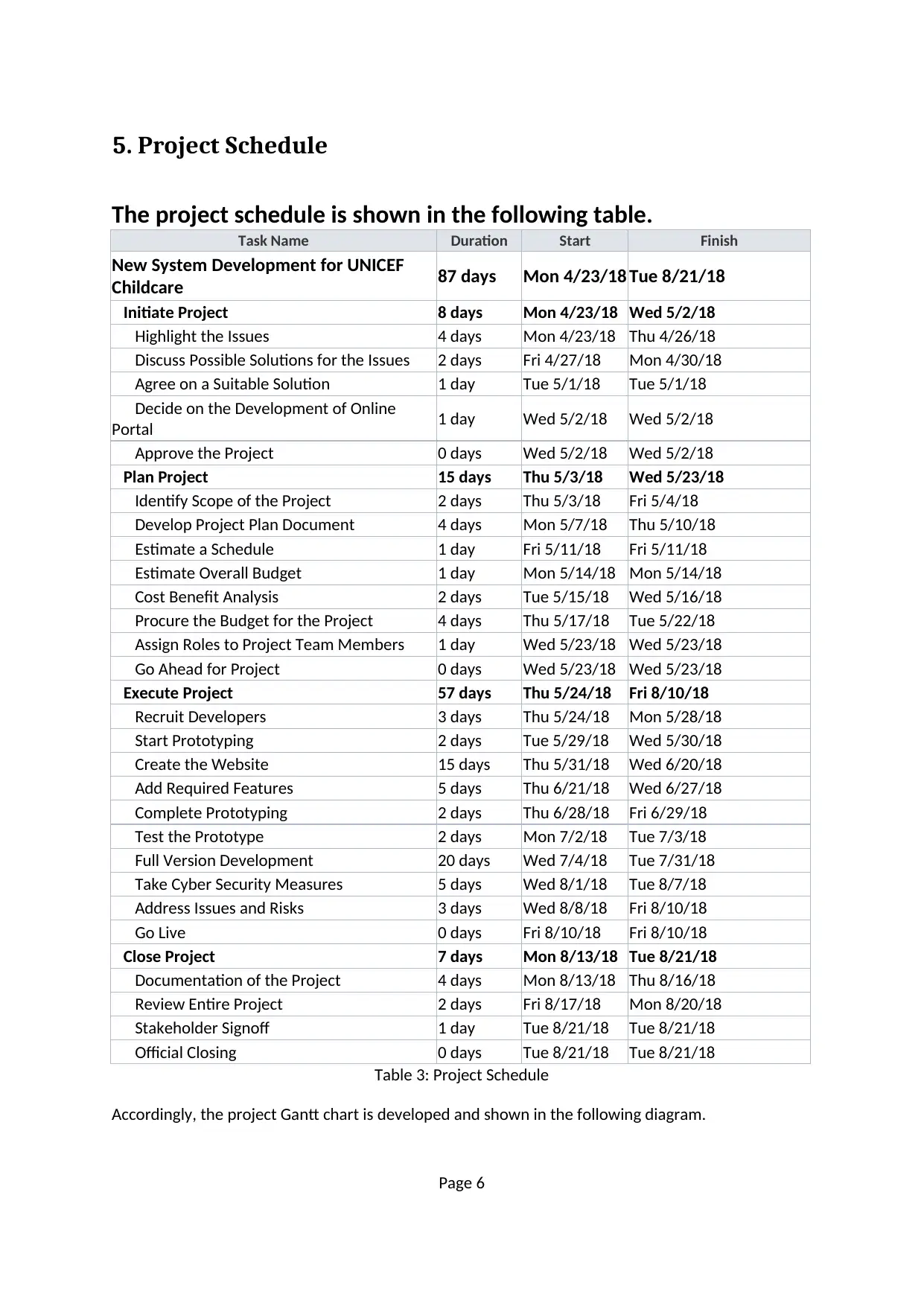
5. Project Schedule
The project schedule is shown in the following table.
Task Name Duration Start Finish
New System Development for UNICEF
Childcare 87 days Mon 4/23/18 Tue 8/21/18
Initiate Project 8 days Mon 4/23/18 Wed 5/2/18
Highlight the Issues 4 days Mon 4/23/18 Thu 4/26/18
Discuss Possible Solutions for the Issues 2 days Fri 4/27/18 Mon 4/30/18
Agree on a Suitable Solution 1 day Tue 5/1/18 Tue 5/1/18
Decide on the Development of Online
Portal 1 day Wed 5/2/18 Wed 5/2/18
Approve the Project 0 days Wed 5/2/18 Wed 5/2/18
Plan Project 15 days Thu 5/3/18 Wed 5/23/18
Identify Scope of the Project 2 days Thu 5/3/18 Fri 5/4/18
Develop Project Plan Document 4 days Mon 5/7/18 Thu 5/10/18
Estimate a Schedule 1 day Fri 5/11/18 Fri 5/11/18
Estimate Overall Budget 1 day Mon 5/14/18 Mon 5/14/18
Cost Benefit Analysis 2 days Tue 5/15/18 Wed 5/16/18
Procure the Budget for the Project 4 days Thu 5/17/18 Tue 5/22/18
Assign Roles to Project Team Members 1 day Wed 5/23/18 Wed 5/23/18
Go Ahead for Project 0 days Wed 5/23/18 Wed 5/23/18
Execute Project 57 days Thu 5/24/18 Fri 8/10/18
Recruit Developers 3 days Thu 5/24/18 Mon 5/28/18
Start Prototyping 2 days Tue 5/29/18 Wed 5/30/18
Create the Website 15 days Thu 5/31/18 Wed 6/20/18
Add Required Features 5 days Thu 6/21/18 Wed 6/27/18
Complete Prototyping 2 days Thu 6/28/18 Fri 6/29/18
Test the Prototype 2 days Mon 7/2/18 Tue 7/3/18
Full Version Development 20 days Wed 7/4/18 Tue 7/31/18
Take Cyber Security Measures 5 days Wed 8/1/18 Tue 8/7/18
Address Issues and Risks 3 days Wed 8/8/18 Fri 8/10/18
Go Live 0 days Fri 8/10/18 Fri 8/10/18
Close Project 7 days Mon 8/13/18 Tue 8/21/18
Documentation of the Project 4 days Mon 8/13/18 Thu 8/16/18
Review Entire Project 2 days Fri 8/17/18 Mon 8/20/18
Stakeholder Signoff 1 day Tue 8/21/18 Tue 8/21/18
Official Closing 0 days Tue 8/21/18 Tue 8/21/18
Table 3: Project Schedule
Accordingly, the project Gantt chart is developed and shown in the following diagram.
Page 6
The project schedule is shown in the following table.
Task Name Duration Start Finish
New System Development for UNICEF
Childcare 87 days Mon 4/23/18 Tue 8/21/18
Initiate Project 8 days Mon 4/23/18 Wed 5/2/18
Highlight the Issues 4 days Mon 4/23/18 Thu 4/26/18
Discuss Possible Solutions for the Issues 2 days Fri 4/27/18 Mon 4/30/18
Agree on a Suitable Solution 1 day Tue 5/1/18 Tue 5/1/18
Decide on the Development of Online
Portal 1 day Wed 5/2/18 Wed 5/2/18
Approve the Project 0 days Wed 5/2/18 Wed 5/2/18
Plan Project 15 days Thu 5/3/18 Wed 5/23/18
Identify Scope of the Project 2 days Thu 5/3/18 Fri 5/4/18
Develop Project Plan Document 4 days Mon 5/7/18 Thu 5/10/18
Estimate a Schedule 1 day Fri 5/11/18 Fri 5/11/18
Estimate Overall Budget 1 day Mon 5/14/18 Mon 5/14/18
Cost Benefit Analysis 2 days Tue 5/15/18 Wed 5/16/18
Procure the Budget for the Project 4 days Thu 5/17/18 Tue 5/22/18
Assign Roles to Project Team Members 1 day Wed 5/23/18 Wed 5/23/18
Go Ahead for Project 0 days Wed 5/23/18 Wed 5/23/18
Execute Project 57 days Thu 5/24/18 Fri 8/10/18
Recruit Developers 3 days Thu 5/24/18 Mon 5/28/18
Start Prototyping 2 days Tue 5/29/18 Wed 5/30/18
Create the Website 15 days Thu 5/31/18 Wed 6/20/18
Add Required Features 5 days Thu 6/21/18 Wed 6/27/18
Complete Prototyping 2 days Thu 6/28/18 Fri 6/29/18
Test the Prototype 2 days Mon 7/2/18 Tue 7/3/18
Full Version Development 20 days Wed 7/4/18 Tue 7/31/18
Take Cyber Security Measures 5 days Wed 8/1/18 Tue 8/7/18
Address Issues and Risks 3 days Wed 8/8/18 Fri 8/10/18
Go Live 0 days Fri 8/10/18 Fri 8/10/18
Close Project 7 days Mon 8/13/18 Tue 8/21/18
Documentation of the Project 4 days Mon 8/13/18 Thu 8/16/18
Review Entire Project 2 days Fri 8/17/18 Mon 8/20/18
Stakeholder Signoff 1 day Tue 8/21/18 Tue 8/21/18
Official Closing 0 days Tue 8/21/18 Tue 8/21/18
Table 3: Project Schedule
Accordingly, the project Gantt chart is developed and shown in the following diagram.
Page 6
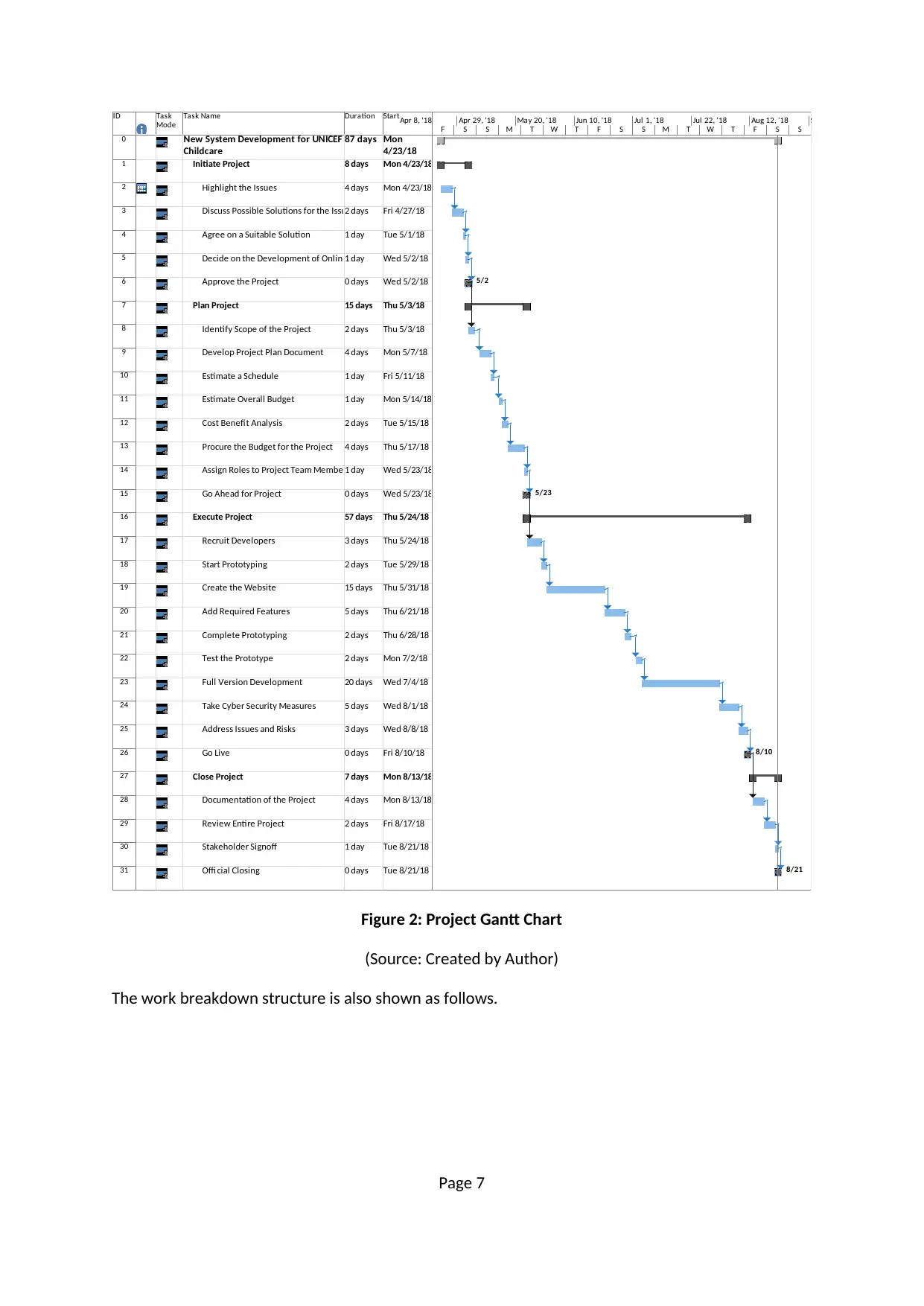
ID Task
Mode
Task Name Duration Start
0 New System Development for UNICEF
Childcare
87 days Mon
4/23/18
1 Initiate Project 8 days Mon 4/23/18
2 Highlight the Issues 4 days Mon 4/23/18
3 Discuss Possible Solutions for the Issues2 days Fri 4/27/18
4 Agree on a Suitable Solution 1 day Tue 5/1/18
5 Decide on the Development of Online Portal1 day Wed 5/2/18
6 Approve the Project 0 days Wed 5/2/18
7 Plan Project 15 days Thu 5/3/18
8 Identify Scope of the Project 2 days Thu 5/3/18
9 Develop Project Plan Document 4 days Mon 5/7/18
10 Estimate a Schedule 1 day Fri 5/11/18
11 Estimate Overall Budget 1 day Mon 5/14/18
12 Cost Benefit Analysis 2 days Tue 5/15/18
13 Procure the Budget for the Project 4 days Thu 5/17/18
14 Assign Roles to Project Team Members1 day Wed 5/23/18
15 Go Ahead for Project 0 days Wed 5/23/18
16 Execute Project 57 days Thu 5/24/18
17 Recruit Developers 3 days Thu 5/24/18
18 Start Prototyping 2 days Tue 5/29/18
19 Create the Website 15 days Thu 5/31/18
20 Add Required Features 5 days Thu 6/21/18
21 Complete Prototyping 2 days Thu 6/28/18
22 Test the Prototype 2 days Mon 7/2/18
23 Full Version Development 20 days Wed 7/4/18
24 Take Cyber Security Measures 5 days Wed 8/1/18
25 Address Issues and Risks 3 days Wed 8/8/18
26 Go Live 0 days Fri 8/10/18
27 Close Project 7 days Mon 8/13/18
28 Documentation of the Project 4 days Mon 8/13/18
29 Review Entire Project 2 days Fri 8/17/18
30 Stakeholder Signoff 1 day Tue 8/21/18
31 Offi cial Closing 0 days Tue 8/21/18
5/2
5/23
8/10
8/21
F S S M T W T F S S M T W T F S S
Apr 8, '18 Apr 29, '18 May 20, '18 Jun 10, '18 Jul 1, '18 Jul 22, '18 Aug 12, '18 Sep 2, '18
Figure 2: Project Gantt Chart
(Source: Created by Author)
The work breakdown structure is also shown as follows.
Page 7
Mode
Task Name Duration Start
0 New System Development for UNICEF
Childcare
87 days Mon
4/23/18
1 Initiate Project 8 days Mon 4/23/18
2 Highlight the Issues 4 days Mon 4/23/18
3 Discuss Possible Solutions for the Issues2 days Fri 4/27/18
4 Agree on a Suitable Solution 1 day Tue 5/1/18
5 Decide on the Development of Online Portal1 day Wed 5/2/18
6 Approve the Project 0 days Wed 5/2/18
7 Plan Project 15 days Thu 5/3/18
8 Identify Scope of the Project 2 days Thu 5/3/18
9 Develop Project Plan Document 4 days Mon 5/7/18
10 Estimate a Schedule 1 day Fri 5/11/18
11 Estimate Overall Budget 1 day Mon 5/14/18
12 Cost Benefit Analysis 2 days Tue 5/15/18
13 Procure the Budget for the Project 4 days Thu 5/17/18
14 Assign Roles to Project Team Members1 day Wed 5/23/18
15 Go Ahead for Project 0 days Wed 5/23/18
16 Execute Project 57 days Thu 5/24/18
17 Recruit Developers 3 days Thu 5/24/18
18 Start Prototyping 2 days Tue 5/29/18
19 Create the Website 15 days Thu 5/31/18
20 Add Required Features 5 days Thu 6/21/18
21 Complete Prototyping 2 days Thu 6/28/18
22 Test the Prototype 2 days Mon 7/2/18
23 Full Version Development 20 days Wed 7/4/18
24 Take Cyber Security Measures 5 days Wed 8/1/18
25 Address Issues and Risks 3 days Wed 8/8/18
26 Go Live 0 days Fri 8/10/18
27 Close Project 7 days Mon 8/13/18
28 Documentation of the Project 4 days Mon 8/13/18
29 Review Entire Project 2 days Fri 8/17/18
30 Stakeholder Signoff 1 day Tue 8/21/18
31 Offi cial Closing 0 days Tue 8/21/18
5/2
5/23
8/10
8/21
F S S M T W T F S S M T W T F S S
Apr 8, '18 Apr 29, '18 May 20, '18 Jun 10, '18 Jul 1, '18 Jul 22, '18 Aug 12, '18 Sep 2, '18
Figure 2: Project Gantt Chart
(Source: Created by Author)
The work breakdown structure is also shown as follows.
Page 7
⊘ This is a preview!⊘
Do you want full access?
Subscribe today to unlock all pages.

Trusted by 1+ million students worldwide
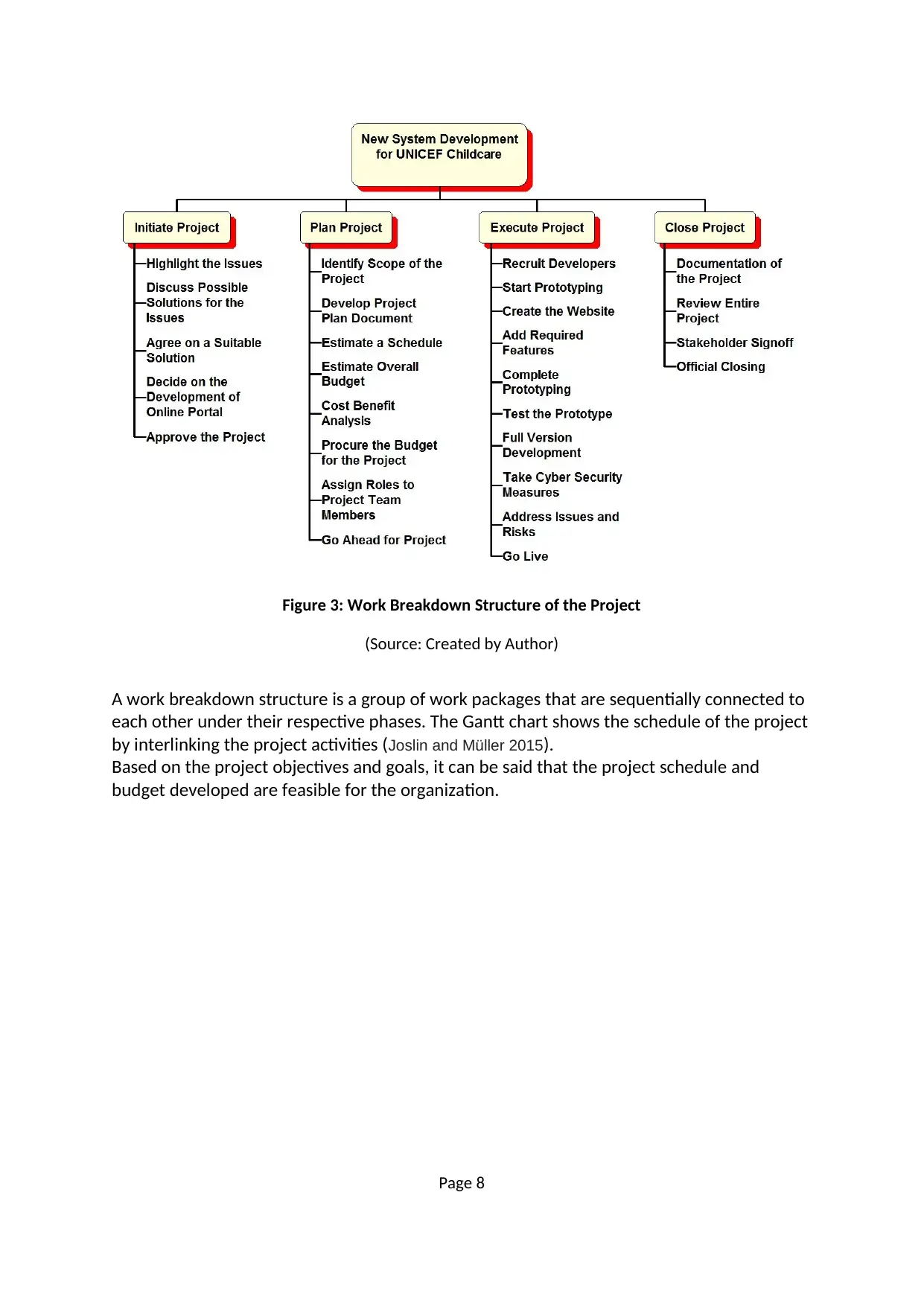
Figure 3: Work Breakdown Structure of the Project
(Source: Created by Author)
A work breakdown structure is a group of work packages that are sequentially connected to
each other under their respective phases. The Gantt chart shows the schedule of the project
by interlinking the project activities (Joslin and Müller 2015).
Based on the project objectives and goals, it can be said that the project schedule and
budget developed are feasible for the organization.
Page 8
(Source: Created by Author)
A work breakdown structure is a group of work packages that are sequentially connected to
each other under their respective phases. The Gantt chart shows the schedule of the project
by interlinking the project activities (Joslin and Müller 2015).
Based on the project objectives and goals, it can be said that the project schedule and
budget developed are feasible for the organization.
Page 8
Paraphrase This Document
Need a fresh take? Get an instant paraphrase of this document with our AI Paraphraser
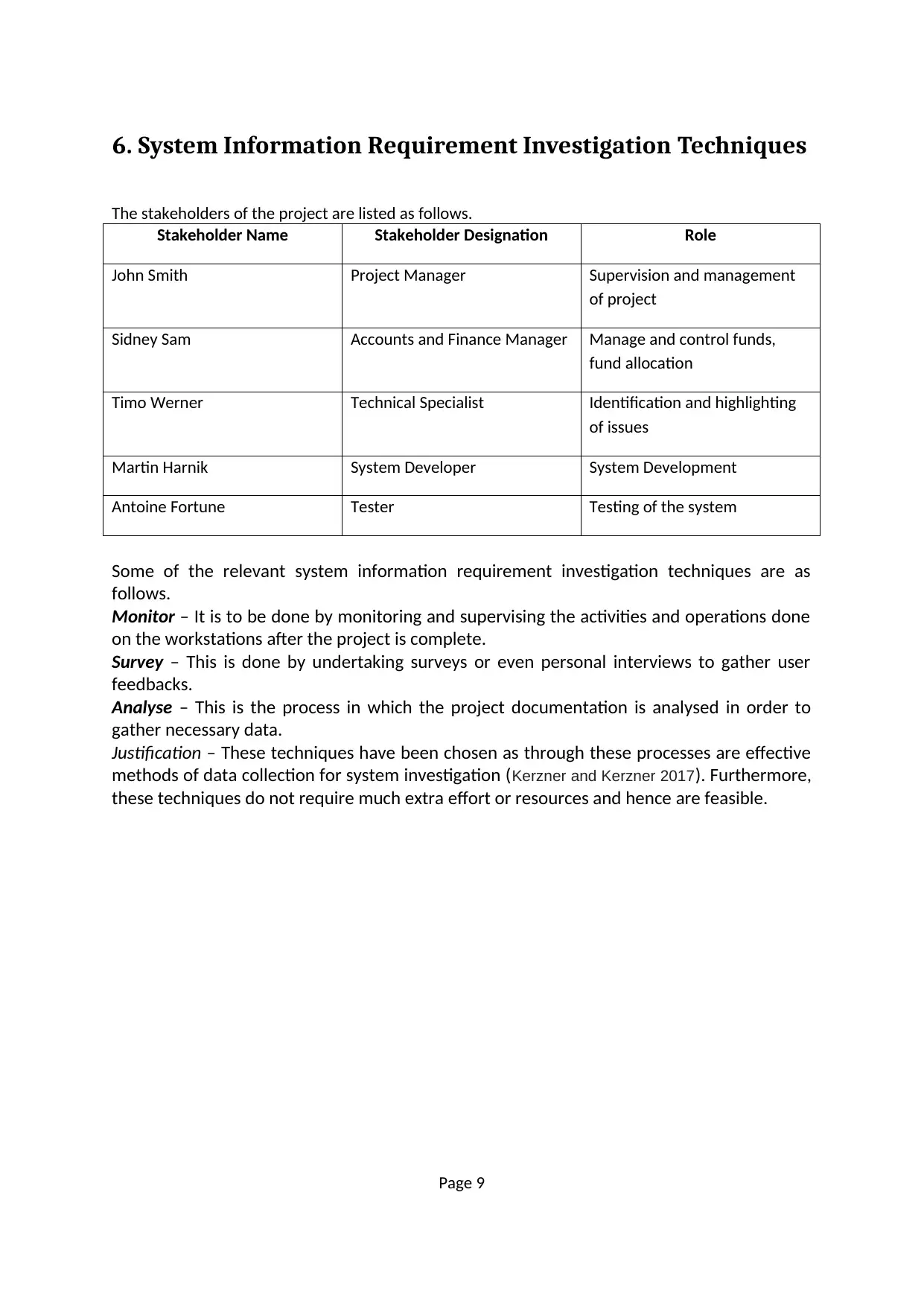
6. System Information Requirement Investigation Techniques
The stakeholders of the project are listed as follows.
Stakeholder Name Stakeholder Designation Role
John Smith Project Manager Supervision and management
of project
Sidney Sam Accounts and Finance Manager Manage and control funds,
fund allocation
Timo Werner Technical Specialist Identification and highlighting
of issues
Martin Harnik System Developer System Development
Antoine Fortune Tester Testing of the system
Some of the relevant system information requirement investigation techniques are as
follows.
Monitor – It is to be done by monitoring and supervising the activities and operations done
on the workstations after the project is complete.
Survey – This is done by undertaking surveys or even personal interviews to gather user
feedbacks.
Analyse – This is the process in which the project documentation is analysed in order to
gather necessary data.
Justification – These techniques have been chosen as through these processes are effective
methods of data collection for system investigation (Kerzner and Kerzner 2017). Furthermore,
these techniques do not require much extra effort or resources and hence are feasible.
Page 9
The stakeholders of the project are listed as follows.
Stakeholder Name Stakeholder Designation Role
John Smith Project Manager Supervision and management
of project
Sidney Sam Accounts and Finance Manager Manage and control funds,
fund allocation
Timo Werner Technical Specialist Identification and highlighting
of issues
Martin Harnik System Developer System Development
Antoine Fortune Tester Testing of the system
Some of the relevant system information requirement investigation techniques are as
follows.
Monitor – It is to be done by monitoring and supervising the activities and operations done
on the workstations after the project is complete.
Survey – This is done by undertaking surveys or even personal interviews to gather user
feedbacks.
Analyse – This is the process in which the project documentation is analysed in order to
gather necessary data.
Justification – These techniques have been chosen as through these processes are effective
methods of data collection for system investigation (Kerzner and Kerzner 2017). Furthermore,
these techniques do not require much extra effort or resources and hence are feasible.
Page 9
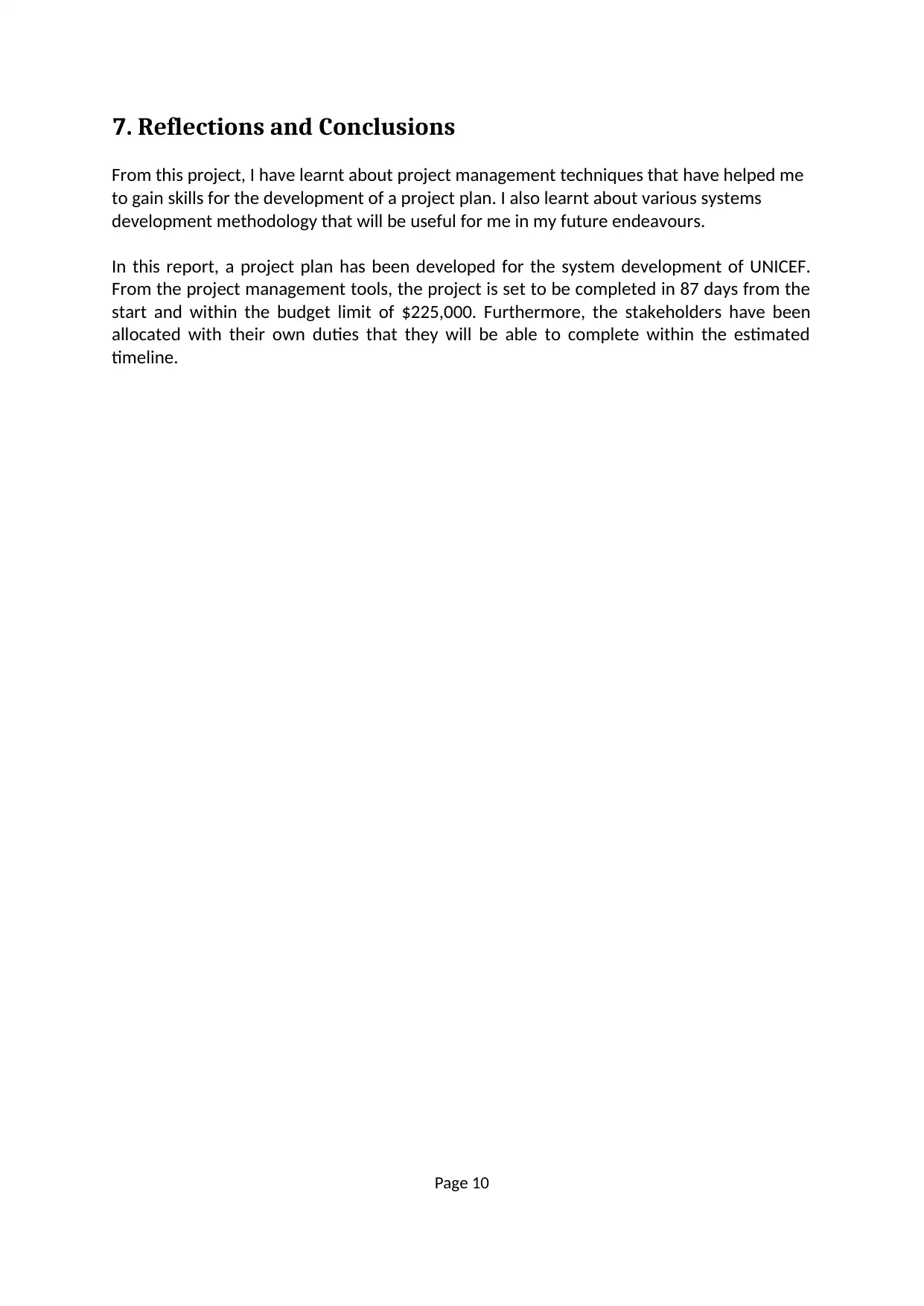
7. Reflections and Conclusions
From this project, I have learnt about project management techniques that have helped me
to gain skills for the development of a project plan. I also learnt about various systems
development methodology that will be useful for me in my future endeavours.
In this report, a project plan has been developed for the system development of UNICEF.
From the project management tools, the project is set to be completed in 87 days from the
start and within the budget limit of $225,000. Furthermore, the stakeholders have been
allocated with their own duties that they will be able to complete within the estimated
timeline.
Page 10
From this project, I have learnt about project management techniques that have helped me
to gain skills for the development of a project plan. I also learnt about various systems
development methodology that will be useful for me in my future endeavours.
In this report, a project plan has been developed for the system development of UNICEF.
From the project management tools, the project is set to be completed in 87 days from the
start and within the budget limit of $225,000. Furthermore, the stakeholders have been
allocated with their own duties that they will be able to complete within the estimated
timeline.
Page 10
⊘ This is a preview!⊘
Do you want full access?
Subscribe today to unlock all pages.

Trusted by 1+ million students worldwide
1 out of 13
Related Documents
Your All-in-One AI-Powered Toolkit for Academic Success.
+13062052269
info@desklib.com
Available 24*7 on WhatsApp / Email
![[object Object]](/_next/static/media/star-bottom.7253800d.svg)
Unlock your academic potential
Copyright © 2020–2025 A2Z Services. All Rights Reserved. Developed and managed by ZUCOL.





